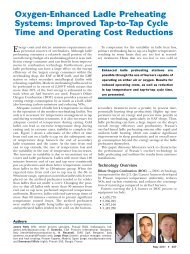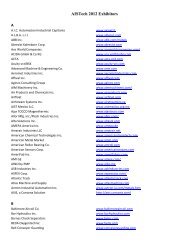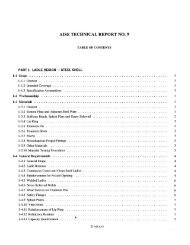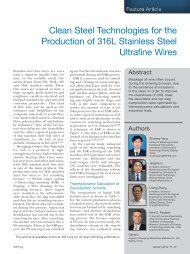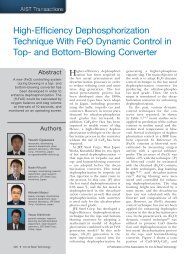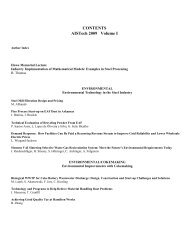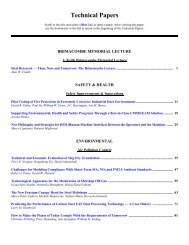Decarburization Efficiency in EAF With Hot Metal ... - Steel Library
Decarburization Efficiency in EAF With Hot Metal ... - Steel Library
Decarburization Efficiency in EAF With Hot Metal ... - Steel Library
Create successful ePaper yourself
Turn your PDF publications into a flip-book with our unique Google optimized e-Paper software.
<strong>in</strong>jectors had to be always operated at maximum available<br />
capacity. In case of lower charge carbon contents<br />
(20–40% hot metal), the deviations are more significant.<br />
It is believed that the deviations were caused by<br />
<strong>in</strong>consistent process conditions, among them manual<br />
control of power and chemical energy <strong>in</strong>put, as well<br />
as <strong>in</strong>correct identification of decarburization reaction<br />
launch.<br />
The decarburization reaction efficiency was also evaluated<br />
us<strong>in</strong>g an alternative method, based on sampleto-sample<br />
carbon content difference and elapsed time<br />
between the samples. This method could not be used<br />
for higher carbon contents.<br />
The first sample used to be taken when more or less<br />
flat bath conditions were identified, i.e., when the progress<br />
of decarburization reaction reached 60% or more<br />
for charges with 35–40% hot metal. The second sample<br />
was usually taken close to the superheat<strong>in</strong>g end.<br />
Although the accuracy of carbon content evaluation<br />
<strong>in</strong> the first sample can be questionable, the obta<strong>in</strong>ed<br />
results (Figure 9) are very <strong>in</strong>terest<strong>in</strong>g. Similarly, as <strong>in</strong><br />
the previous case, the relation between carbon content<br />
<strong>in</strong> the liquid bath and the actual decarburization rate<br />
is rather clear. Moreover, the trendl<strong>in</strong>e for all available<br />
results is almost identical to the one <strong>in</strong>dicated <strong>in</strong><br />
Figure 8.<br />
The decarburization rates estimated by the second<br />
method are higher than <strong>in</strong> the first case. This can<br />
probably be expla<strong>in</strong>ed by too-high carbon content<br />
analyzed <strong>in</strong> the <strong>in</strong>itial samples, which were not fully<br />
representative of the whole volume of the liquid bath<br />
<strong>in</strong> the furnace.<br />
Performance Data<br />
All three furnaces presented <strong>in</strong> this paper are almost<br />
identical from the design po<strong>in</strong>t of view. The difference<br />
between adopted hot metal charg<strong>in</strong>g practice has<br />
been considered less significant for such performance<br />
<strong>in</strong>dexes as specific energy consumption, lance oxygen<br />
consumption and productivity. Therefore, the available<br />
performance data have been evaluated jo<strong>in</strong>tly.<br />
Figure 11<br />
Specific lance oxygen consumption.<br />
Figure 10<br />
Specific energy consumption results (to liquid steel).<br />
The specific electrical energy consumption results<br />
are shown <strong>in</strong> Figure 10.<br />
For the most frequent charge configuration of<br />
30–40% hot metal, the energy consumption is 220–180<br />
kWh/ton, respectively. <strong>With</strong> 70% hot metal, it is practically<br />
“zero consumption.” For this charge configuration,<br />
practically observed, very limited energy was consumed<br />
<strong>in</strong> the <strong>in</strong>itial part of the heat or before tapp<strong>in</strong>g for the<br />
f<strong>in</strong>e adjustment of required tap temperature.<br />
The lance oxygen consumption results are shown <strong>in</strong><br />
Figure 11. The deviations observed on the graph are<br />
related to the fact that oxygen consumed for silicon<br />
oxidation could not be filtered out <strong>in</strong> a predictable way.<br />
Also, the earlier mentioned <strong>in</strong>consistency <strong>in</strong> <strong>in</strong>jection<br />
system operation with manual control is significant.<br />
Increase of the hot metal share <strong>in</strong> the furnace charge<br />
to 70% dramatically <strong>in</strong>creases the oxygen consumption.<br />
The required oxygen volume <strong>in</strong> lance mode is about<br />
6,000 Nm 3 per heat. <strong>With</strong> six CONSO units operat<strong>in</strong>g<br />
at 2,500 Nm 3 /hour, lance oxygen <strong>in</strong>jection can be<br />
completed <strong>in</strong> less than 25 m<strong>in</strong>utes, with the average<br />
decarburization rates of 0.12–0.14% C/m<strong>in</strong>ute, which<br />
corresponds to the values practically observed dur<strong>in</strong>g<br />
normal operation.<br />
Figure 12<br />
<strong>EAF</strong> productivity results.<br />
68 ✦ Iron & <strong>Steel</strong> Technology A Publication of the Association for Iron & <strong>Steel</strong> Technology



